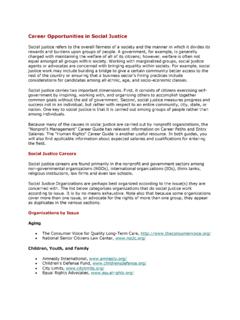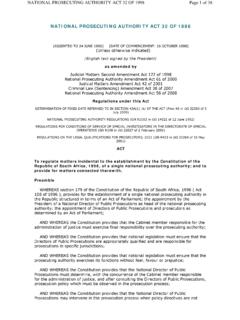Transcription of Cross-national comparison of youth justice
1 Cross-national comparison of youth justice Author: Neal Hazel, The University of Salford YJB 2008 Cross-national comparison of youth justice 2 Contents Acknowledgements 4 Executive summary 5 1 Introduction 12 Comparative analysis and youth justice 12 Aims of this study 12 Remit and structure of this report 13 2 Methods 15 Comparative analysis 15 Data collection 16 Analysis 17 3 Competing pressures on youth justice systems 19 International pressure 19 Other pressures 21 4 System models and key principles 23 System models 23 The welfare model 23 The justice model 24 More complex
2 Models introduced 25 Key system principles 26 Best interests/welfare of the child 27 Parens patriae 27 Young people who offend as children in trouble 27 Minimal intervention 28 Protection of society 28 Education and resocialisation 29 Social integration 29 5 Age thresholds within systems 30 Age of criminal responsibility 30 Lowering the age of criminal responsibility: early intervention 32 Lowering the age of criminal responsibility: anti-social behaviour 33 Raising the age of criminal responsibility: doli incapax 33 Raising the age of criminal responsibility: welfare processes 33 Raising the age of criminal responsibility: restricting disposals 34 Age of criminal majority 34 Lowering the age of criminal majority: transfer to adult courts 35 Raising the age of criminal majority.
3 Extending juvenile processes and disposals 36 6 Prevention and early intervention 37 Cross-national comparison of youth justice 3 Criminal justice or social welfare contexts for prevention 37 The at risk paradigm and alternative frameworks 38 Family-focused initiatives 39 School-focused initiatives 40 Initiatives directed towards at risk children 41 Authoritarian controls 42 7 Investigations and decision-making processes 44 Investigations 44 Juvenile specialism 44 Interrogations and police power 45 Issue of delay in proceedings 45 Decision-making processes 46 Due process during youth hearings 46 The emergence of diversion 47 Diversion by the police 48 The role of other gatekeepers 50 Informal hearings 50 Criticisms of diversion 52 8 Outcomes and disposals 53 Restorative outcomes 53 Victim-offender mediation 54 Reparation 55 Other community penalties 56 Responsibility of parents 56 Public censure 56 Social welfare 57 Use of education 57 Supervision and multi-agency support 57 Other forms of social control 58 Removal from family home/placed into non-custodial care 58 Community-based institutions 58 Custody 59 Extent of
4 The use of custody 59 Custody as a last resort 60 Other methods of reducing custody rates 61 Length of custody 62 Types of custodial sentences and regimes 63 Incentives and discipline in custody 64 Issue of remand prisoners 64 Conditions in custody 65 Aftercare 65 9 Conclusions 67 References 70 Cross-national comparison of youth justice 4 Acknowledgements As always, a number of people have assisted in the preparation of this report. I am grateful to the youth justice Board for England and Wales (YJB) for funding the research (of which this represents the final report), and in particular Nisha Patel for managing the research and Helen Powell for shepherding the application.
5 I would also like to express my gratitude to the support staff at the Institute for Social, Cultural and Policy Research (particularly Mary Byrne) and at the School for English, Sociology, Politics and Contemporary History (particularly Beryl Pluples) for their help in administering the report. I am also grateful to Dr Christopher Birkbeck for his help and information relating to South American jurisdictions and translation. In addition, thanks go to Jackie Bowers in the University s Information Services Department for her help in accessing electronic databases. I am particularly grateful to Sarah Wands for her work on this research, including involvement in data collection, analysis, and translation.
6 Neal Hazel, The University of Salford Cross-national comparison of youth justice 5 Executive summary Background to the research This volume is the final report in a Cross-national scoping review of policy and practice in juvenile justice . In common with other areas of social policy, youth justice is of increasing interest in comparative analysis to researchers and policymakers. This is partly fuelled by international obligations and harmonisation, and partly by the attractions of policy diffusion , whereby one country can learn and transfer policies and practices from another. Commentators have noted the Cross-national concerns raised by youth justice . This study aims to explore several key questions at both the system-wide and individual case levels.
7 It focuses on: overall approaches taken by systems (including aims, philosophies, pressures and trends) structures and procedures for the administration of youth justice (including relevant agencies, judicial processes, diversionary practices) interventions (including differences within each intervention, custodial provision, aftercare). The study will also highlight some illustrations of innovative or good practice. The key purpose of this report is to present findings on comparative patterns in youth justice approaches, policy and provision across jurisdictions. It does so by first considering the pressures that countries face in relation to youth justice , and also common models and principles within systems.
8 These provide a reference framework to explore policy and practice similarities and divergences in the four areas of: age thresholds for entering and leaving juvenile justice prevention and early intervention processes in youth justice , including investigations and decision-making outcomes and disposals, including a particular focus on restorative outcomes, other community penalties and variations in the use of custody. Competing pressures on youth justice systems The development and implementation of policies and practices are subject to a number of pressures both internal and external to each country. Tension between these competing pressures is played out in debates and formulation of policy.
9 Policies adopted can be seen as the real-life result of how each of these pressures are (temporarily) borne in each country. Most international pressure comes from a number of prominent United Nations agreements. The most significant of these is the United Nations (UN) Convention on the Rights of the Child 1989, which states, among other things, that the best interests of the child must always be the primary consideration and that custody should only be used as Cross-national comparison of youth justice 6 a last resort. Implementation of the convention is monitored and pressure is put on countries to comply through public censure. Other Unied Nations agreements have set standards for: the process of youth justice , with a focus on children s rights, including recommending that the age of criminal responsibility is not set too young early intervention in the cases of abused children rules governing custody.
10 European countries are also subject to the European Convention on Human Rights 1989, and consequent rulings of the European Court of Human Rights. There are also recommendations made by the Committee of Ministers of the Council of Europe. While affected by these international pressures, each system is subject to political agendas, media panics and public opinion at the national and local level. It is possible to identify similar types of moral panics over youth crime around the world. The result of these pressures is that youth justice systems are extraordinarily varied, while at the same time there are patterns and trends in policy development. System models and key principles It is possible to identify system models around the world, however these are only ideal types and not replicated exactly.


















